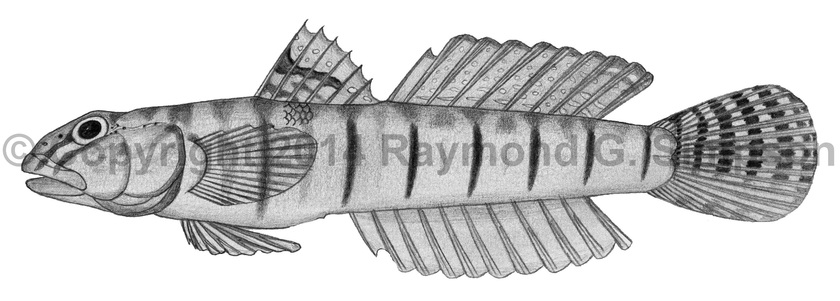
Common Name
Yellow River Goby
Year Described
Valenciennes 1837
Identification
Dorsal Fin: VI, I, 9-10
Anal Fin: I, 9-11
Pectoral Fin: 14-16
Pelvic Fin: I, 5
Scales: 51-58 (lateral rows)
Head large with fleshy cheeks and a smallish eye. Mouth size dimorphic (larger in males). Clavicular area under gill cover with prominent fleshy projections directed anteriorly. Two cephalic pores in the interorbital region. Seven pores in two sections: one set of five immediately behind orbit and a set of two behind upper opercular flap (subgenus Euctenogobius). Vomer without teeth. Head, cheeks, and pectoral base scaleless. Body fully scaled. There are 17-25 predorsal scales. Median fins not confluent with caudal fin.
Color
Body whitish to yellowish, with a greenish cast in life. There are around eight thin purplish-brown bands on the body, and an equal number of saddles in between the full bands. There is another band on the opercle and across the back of the head and two lines from the snout to the anterior orbit. First dorsal fin with a dark (can be bright red to orange) stripe with a white stripe above it. Second dorsal fin with pale and dark speckling. Caudal fin with brown spot-bands on dorsal 2/3 of fin. Other fins pale.
Size
Maximum size to 8.2cm SL.
Habitat
Found in estuaries and freshwater rivers.
Range
Atlantic slope drainages from Colombia to N. Brazil.
References
Lasso-Alcalá, O.M. & C.A. Lasso. 2008. Revisión taxonómica del género Awaous Valenciennes 1837 (Pisces: Perciformes, Gobiidae) en Venezuela, con notas sobre su distribución y hábitat. Memoria de la Fundación La Salle de Ciencias Naturales, 67,168, [for 2007], 117–114.
Watson, R.E. 1996. Revision of the subgenus Awaous (Chonophorus) (Teleostei: Gobiidae). Ichthyol. Explor. Freshwat. 7(1):1-18.